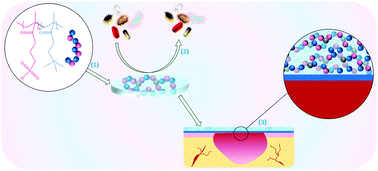Healing kinetics of diabetic wounds controlled with charge-biased hydrogel dressings
Abstract
The present study investigates the properties and use as wound-dressing materials of hydrogels made of negatively charged 3-sulfopropyl methacrylate (SA) and positively charged [2-(methacryloyloxy)ethyl]trimethylammonium (TMA) to form poly(SA-co-TMA) gels with/without a charge bias. Their actual chemical compositions were ascertained by XPS which revealed a fair control of the final gel composition obtained from the initial molar ratio in the reaction solution. Zeta potential measurements confirmed the controlled charge bias on which swelling ratio was found to strongly depend, i.e., positively charged or negatively charged gels have a higher tendency to swell than poly(SA-co-TMA) made of 50 mol% of each unit. The anti-biofouling properties were also correlated to the charge bias, i.e., negatively charged and neutral gels resisted well to biofouling by fibrinogen and whole blood, and were much less cytotoxic than their positive counterparts. Applied as wound-dressing materials onto diabetic wounds, it was found that wound closure was almost reached after 21 days, regardless of the gel composition. However, histological analysis revealed that positively charged gels accelerated hemostasis, while neutral gels, much less cytotoxic, were more efficient in the following stages during which the granulation layer and dermis were fully remodelled leading to a dense fibroblast population and thick collagen with no sign of inflammation. All in all, this study sheds light on the effects of charge bias on different wound healing stages and proves the efficiency of pseudo-zwitterionic poly(SA-co-TMA) to heal diabetic wounds for the first time.



 Please wait while we load your content...
Please wait while we load your content...